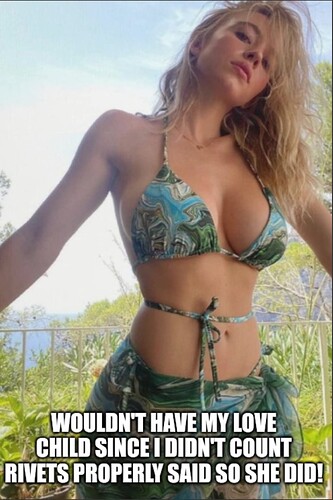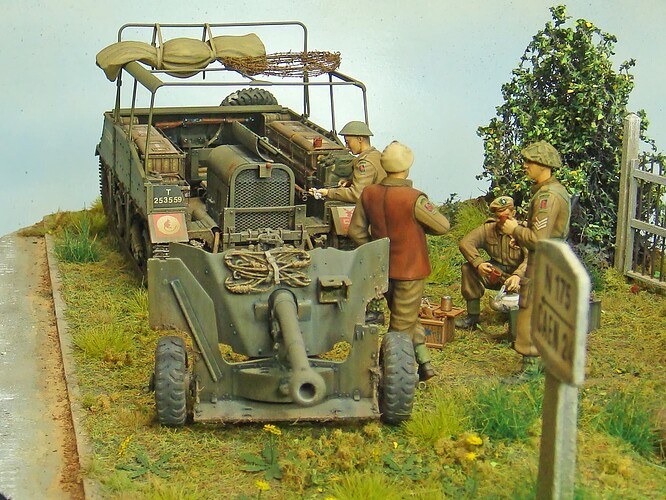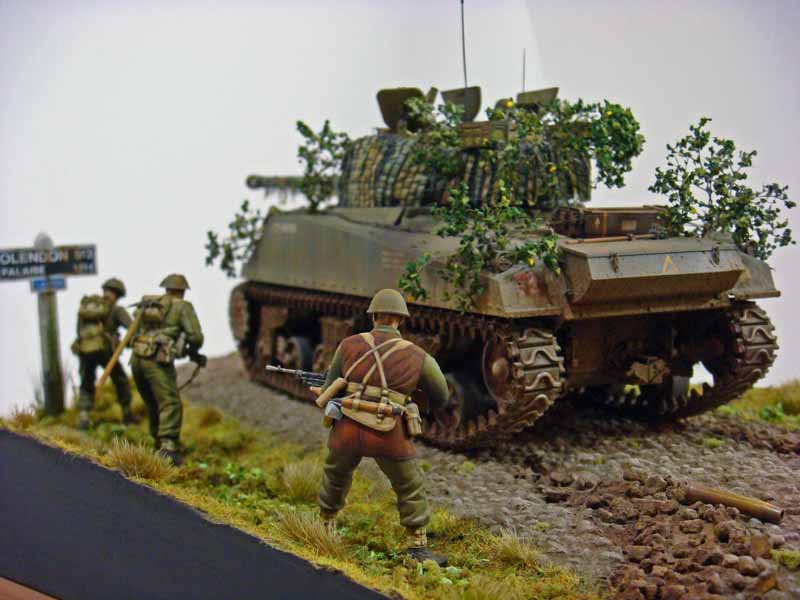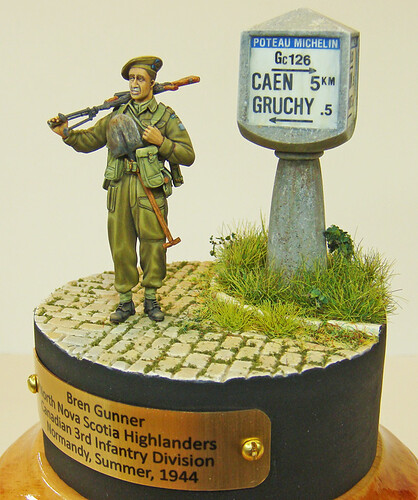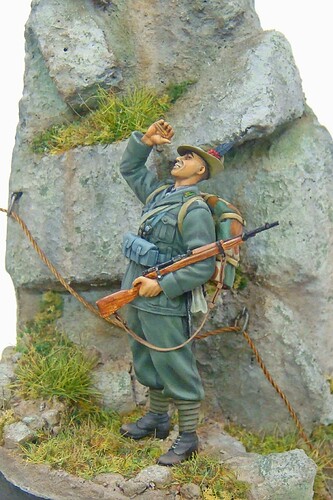Excellent point Uncle. I bought trillions of every military insignia from Corps to Division on down, but not any instructions where they go,
I’m sorry, I didn’t realize the latter category was a thing, probably because I don’t pay attention to anything except why’s before my eyes. My bad. Good point.
*AB:
I’ve only been on this forum for less than one month and the radical historiographers have been out on Chauvinistic head hunts for guys like me who may have a different, yet not “proper “ idea of how to depict Lt. Wienerscnitzel’s “ Jagdtiger. There is a pall of orthodoxy in some quarters which simply enjoys propping up an unprovable thesis and then dares YOU to disprove it. I’ll stick with my heterodox philosophy as I’ve opined on with respect to to this topic. Thanks
Dan
There’s harsh consequences for neglecting to split hairs in the model hobby based on my personal experience…
…broke my evil heart they did.
On a serious note, based on the information available and diligence an accurate picture of what went on with painting panzer appears thanks to the works of Jentz, Doyle and Chorý. How serious a modeler wants to take accuracy is a personal choice.
While I personally despise faded BLUE panzers, it positively is within someone else’s wheel house to model those blue biscuits ![]() ,
,
I can’t and won’t say, that a faded BLUE Pz IV that’s been in the field for like three weeks, looks good when it screams exactly the opposite in my view. In my view it’s garbage.
However, I fully agree it’s their prerogative to model how they please. I’ve even awarded trophies to such models at IPMS model contests because the criteria was Basic Construction, not paint, not detail, and not color accuracy.
However, if the BLUE panzer builder goes around saying his or her work is ACCURATE, well since it isn’t that person should expect blow back from others. The three week old BLUE Panzer IV is on par with saying Benjamin Franklin was the first president of the United States…and its very likely to get called out for such if it’s claimed to be accurate. Called out just like undocumented zimmerit on a Cromwell would be called out.
In short, modelers should build and paint as they like. Modelers are perhaps unwise proclaim their work as accurate unless they have credible information to justify said claim.
I totally agree. I ttry to do a meld of both. Leaning to wards the second cohort, but still try to maintain a sense of realism. I dont rivet count, but i dont paint my tanks pink either. I do use references to help a bit of realism, but not sacrifice my FUN. Its all about habing fun. Besides, unless its entered into a contest, 99% of the kits will never be seen by any others than family, friends, maybe your local IPMS club members and yourself. As Stan Lee would say " Nuff Said,"
I’m under no illusions that I’m the “be-all-end-all” when it comes to research, but I am generally very confident when it comes to “knowing what I DO know” and having a willingness to admit and recognize the “gaps” in my own research. I tend to do a LOT of research on my builds, and in many ways, the models, themselves, are more like extensions of my research than standalone projects. Sometimes I’d be hard pressed to say with certainty that I did the research to build an accurate model, or whether I built that model to confirm and internalize my research. (The process of actually building and figuring out how to replicate something is sometimes the best way to understand that something.)
This means that at shows and online I generally let the “smart aleck” comments roll off me like water from a duck’s back. It’s very rare that they’re telling me (or saying out loud to their audience) something that I didn’t already know (but probably disagree with). Most of the time, I find they’re just plain wrong and spouting off the modeler’s equivalents of “urban legends.” In other words, they’re babbling on like ignorant, uninformed fools about something they only think they know a lot about.
At shows, I’m quite liable to just ask the commenter to “tell me more” as he “holds court.” “Wow, really? What about this?” We’ll eventually get around to his information “sources” (which are usually either out of date or - very often - just something they’ve heard or read on the interweb with no sources cited, i.e. “modeler’s urban legends”). Sooner or later, the “expert” will talk himself into a metaphorically inescapable corner (making absolute, factual assertions with nothing to back them up and realizing that he’s sounding foolish) and then find some excuse to physically “run away.”
However, this inquisitive approach will sometimes lead me to a “no kidding” real expert (or at least someone who’s done more research than me and who is equally as connected to the subject). In those cases, I’m happy to learn what I can and pump the guy for even more info. I have made a number of good friends this way, and those conversations have often opened new doors to me with regards to research and other related areas.
I also pretty much dismiss comments on matters of style and aesthetics. Issues like exact colors, weathering, pushing and pulling shadows and highlights, etc. fall into the realm of what I consider personal stylistic biases and preferences. I have my own which I’m very comfortable with, and I’m willing to accept that not everybody shares my own biases and preferences for those things.
Again, I just let those comments roll off me. My experience has been (over decades and decades of model shows) that if I bother to find out anything about the commenter and then seek out his work on exhibit, that either: (1) He has no models in the show, and no one can ever remember the last time he entered a model in a show… i.e. he’s not a model builder, just a self-proclaimed model “critic;” or (2) His own models look like … well, let’s be generous and say “basic and amateurish.” In either case, the critic’s comments are not worth anything to me, especially not enough to make me reconsider changing my own style and techniques.
However, like the “subject matter expert,” I do sometimes find someone at a show (or online, etc.) whose work I really like and who has demonstrated some technique or used some color pallet that I find admirable and who I will go out of my way to seek out to inquire about the details of that work. In a similar vein, I’ll often find myself at the end of a show standing around someone else’s work anticipating that I can meet the builder to either personally complement him (or her) or to ask some question or another about how or why they did something.
Oh well, enough of my own rambling on… Just about done with my morning coffee which means it’s time to get on with something productive. LOL!
Happy modeling!
You do realise that could be the genesis of an army for the “Hordes of the Things” wargames rules? Given that in mythology Unicorns could only be ridden by Virgins, and artillery crews often laboured stripped to the waist (a habit shared by certain feminist protesters) we could be looking at an army of (near) naked ladies. Better stock up on the pink paint…
Cheers,
M
![]()
![]()
LOL! That made my day!
Spelling police strikes again.
Please. I can’t take it anymore …
![]()
Calvary is not the same as cavalry. Cavalry could be leading someone to a calvary
but a calvary will never get on a horse although a special type of wooden horse could possibly be found at or near a calvary.
Calvary: Calvary Definition & Meaning - Merriam-Webster
Cavalry: Cavalry Definition & Meaning - Merriam-Webster
Calgary: Calgary - Wikipedia
Edited my spelling error just for you Uncle-Heavy. Thank you!
There are more than one sinner in this topic.
![]()
![]()
Ironic, since that is exactly what I’m currently working on! A little bit of fantasy fun. ![]()
![]()
![]()
![]()
Well my friend, that was perhaps the most thorough and thoughtful disquisition on the topic I’ve read thus far. I like your approach, mindset and attention to detail, yet you hold fast to your own aesthetics. That’s what I like in a modeler: an intelligent person who takes the craft seriously (but, perhaps not him/herself, not) and launches a build which takes us back, diachronically to a time and space in which horror rules the day and these terrible, but effective machines which rolled the Earth existed. I’m sure most modelers here belong to some kind of aesthetic in which they attempt to bring the viewer not only ask in time and space, but also, to bring them into the workaday world of the troops, the machines they used, what combat, weather and time did to those expensive machines. It’s fascinating when I go to a hobby store and engage an AFV modeler about their choices and why they theme to make them. Some are reticent, but most are sanguine enough to share. I don’t think I would ever criticize a modeler who took a bold decision to try something someone else hasn’t tried, or extend it,. Why? It’s the nature of the art we’re all after. We just don’t build these for no reason. Serious modelers want to evoke the senses, our thirst for history and the reality of cold, dead, war. Now, I won’t be at the shows you’ll be at yet because my skills aren’t like yours, but I’m large measure I follow your heuristics. You seem to be a very smart man and skilled modeler. I would enjoy seeing some of your builds sometime, if only to behold your method and product. Id probably have 100 questions about your choices. I just got 90% on a Jagdtiger but went out for major surgery. But even from my hospital bed I’m reaching out, trying to learn. I collected a number of resources in an attempt to descry what information was relevant to my build and coming up with some overall theme. I chose dark yellow. Boring to most, but not to me as I got to enjoy each phase, including scratch builds, PE and some stowage. But it is things I learn from my betters in this community which makes me a better modeler much faster after much time, failure, and repetition.
I build AFV’s as detail accurate as I can get them after extensive research. My camouflage schemes and markings are historically accurate for a unit; hardly ever a specific vehicle. I have a very decent library and I like to go by photographs. I don’t subscribe to modeler’s myths or urban legends. You won’t find me painting Red Oxide Jagdtigers or Dunklegrau Panthers, or anything illustrated in Panzer Colors.
Rather than bore our fellow Armorama peeps with repeat postings of model, here are a few internal links to threads with some photos of my own work along with a couple of research monographs on various topics:
Making a Folded Back Canvas Tarp
US WW2 + Korean War Antennas reference
Trumpeter 2P19 Launcher with R 17 Missile Scud B
Searching for Soviet 2P19 Scud TEL R 17 Missile Hook Up Information
Working with Photo Etch: An Armor Modeler’s Guide
Fallout Nuka Cola Machine 1/24 Scale
I used to have a bunch of build blogs on the old Armorama, but, alas, they’ve gone the way of the dodo…
Here’s wishing you a speedy recovery and a quick return to your modeling bench!
I will enjoy watching these, but I’ll have to admit I’m short on monographs . You are a true intellectual artist my friend.
Dan
Cheers!
I figure that by sharing some of my research results that I’m somehow paying off a little bit of my Karmic debt to the greater modeling community. I’ve learned so much over the years from others who were generous and free with their knowledge, skills, and art that have certainly built up a mountain of debt to the community… Keeping my own head right can’t be a bad thing in the end.
SdAufKla:
Do you set out with a theme or vision for a build or do you let the piece speak to you as to where it wants to go? I’ve built some afvs that I had delusions of grandeur of, but then I tacked the other way because the following winds of the piece were driving me elsewhere.
I will say that I do try to have some historical connection on a build. For instance, I just was finishing up a Henschel Jagdtiger by Dragon. I wanted it be a three tone ambush camo from SPAbt 512, but I went with the 653rd because I found more data on them and I also had metal stencils for the special heavy 653rd. They came out great and I was able to locate them after much painstaking research. Apart from that, it’s a relatively anonymous build as it lacks any historical or emprical cognate. I just wanted it to be a dark yellow JT in the 1st Kompanie of the 653rd, #114. Unfortunately, being a JT nut (I own virtually every kit including the massive Trumpeter 1/16 version (bought the build book on it), I decided I’d need a massive cache of stencils to accurately portray at least the special heavy battalions, but with interchangeable numbers, all instead of 331, 332 or 114.
Someday, I hope to reach the doorstep of your arsenal of techniques. Aye, you’re a worthy artist.
Hmmm…? I always start with some pretty clear idea of what I want the final outcome to look like. However, I’m not so set in stone that I never change or modify that vision as I progress. I do a lot of experimenting with composition and trial arrangements. Sometimes I do some tests and experiments with various techniques before I commit to the final build. Although I do like to be as historically accurate as I can be, I’m not adverse to making things “fit” the composition, if necessary.
In this Villers-Bocage vignette, the actual road sign was quite a bit further away from the subject Lloyd Carrier and 6pdr AT gun than I have depicted. However, the sign was really important to establish the historical context, so I used my artistic liberty and moved it to where I wanted it in my scene.
Generally, I find that my interest in a particular model subject is born from something that I’m reading or studying about. In those cases, the historical context drives the technical and aesthetic aspects of the model. In those cases, I’ll form a pretty clear mental image of what I’d like to do.
Other times, though, I’ll get deeply interested in a particular subject because of its technical attributes or general historical significance and then I’ll look for a suitable historical context to display it in. Often times I’ll model the scene with a specific idea to show off some interesting technical aspect of the subject.
Here’s an example of the technical interests of the model subject (at least to me!) drove the final composition. I wanted to show off the interior, to include the Ford Flathead V8 engine, so the model is displayed on a downward slope approaching the viewer so that it’s easier to look into the open top of the model. I added space on the base to display the engine deck separately, removed from the model so that the engine could be viewed. The historical context was in keeping with my interest in Canadian WWII units and operations (here the southern Italian mainland) which gave me the mountainous terrain as a rational for the display. The details are “typical” of the area and time, but the scene does not depict a specific historical incident.
Again, at the risk of boring our Armorama mates, here are a couple more examples:
Here I became interested in the Sherman Firefly (and infatuated with the Tasca kit), so I looked for a historical context to put my model in. I’m also deeply interested in the wartime history of the 3rd Canadian Infantry Division (my father-in-law served with them during the war), so after some research I selected an operation where the 3CID was operating with a Canadian armor unit that had Fireflys. The road signage sets the place and time, the insignia on the uniforms and the tank provide the rest.
In this example, the process was kind of the same. I became really interested in Italian armor in the Western Desert and the little-known significance and importance of those units to what is usually all the credit given to Rommel and the Afrika Korps. The M14/41 was a really interesting subject to dig way down into the research rabbit hole, and it was a challenge to make one as accurate as I could. There are a couple of well-known and frequently published photos of an Italian armor unit passing this sign during the battle of the Gazala Line, so I replicated the sign to establish the historical context of the scene. The general low-tech nature of Italian command and control was my inspiration for the dispatch rider and cycle.
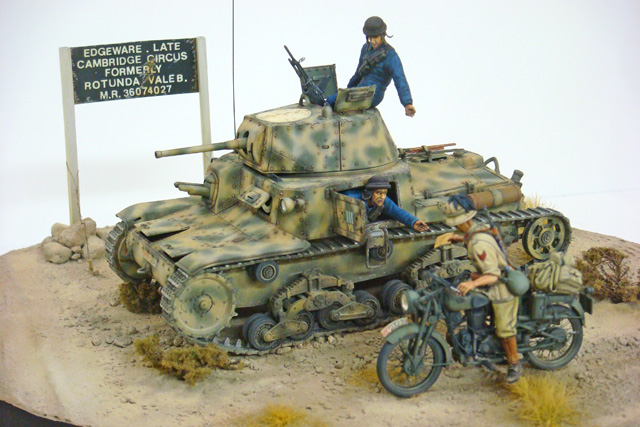
I’ve had a long-standing interest in the battle of Villars-Bocage, and I’ve built a number of models representing different subjects associated with it. This is the Tamiya Cromwell kit dolled out with PE and modified to correctly depict the subject of some of the kit decals. The kit is the wrong version of the tank for the markings, but the markings are correct for the VB subject. Either build a different subject or correct the kit… This was another deep-dive research project (done in the mid-90s when there was hardly any published reference material on the bewildering number of Cromwell versions).
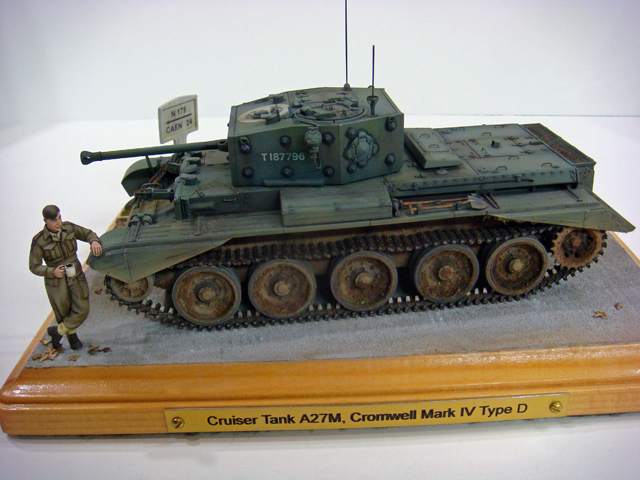
This is one that I did just to honor my father-in-law and his service with the 3CID in Normandy. However, I did spend a lot of time pinning down the precise geographic location to depict and getting the signage accurate.
This is one that I built just because I really liked the model figure. It’s a Hornet figure, and I just loved the sculpting and found the subject unusual and interesting. The scene was researched to get the historical context correct (Italian invasion of France through the Graian Alps in 1940), but that specific details are just my own imagining.
So, yes… I do start out with a pretty clear vision of what I want to model, but the origins of that vision kind of just depend on my interest. How it evolves as the build progress is something more “organic,” but I almost always wind up with something pretty close to my original idea, even if the details have changed.
Well, thank you Sir: to my eye, it seems that much of a build for you begins long before sprues are cut, n’est ce pas? I think I should attempt this more organized approach. I have done much study of how tanks in the field actually looked. You’re a careful planner. I think you’re at a high echelon at this craft so instead of just piecing things together you’re telling , or re-telling , a story. This must doubtlessly be why you’re well-read on most subjects here.
Since I have a penchant for German heavies (probably worse than Hitler himself), I went out and bought many books on the subjects, probably ones you have. Thank you for sharing your methodology. Truly,
Dan
